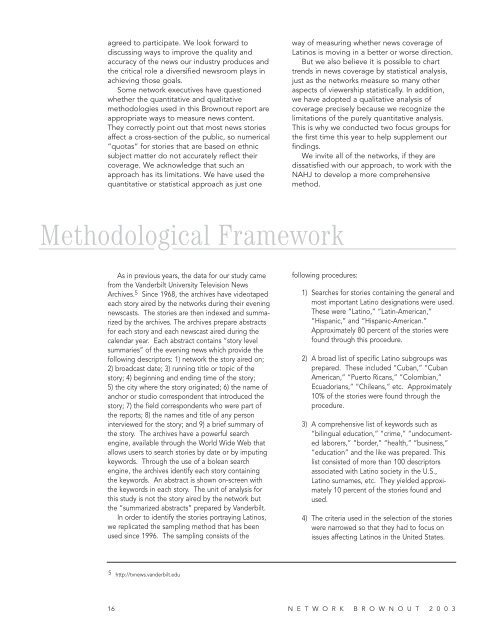You also want an ePaper? Increase the reach of your titles
YUMPU automatically turns print PDFs into web optimized ePapers that Google loves.
agreed to participate. We look forward to<br />
discussing ways to improve the quality and<br />
accuracy of the news our industry produces and<br />
the critical role a diversified newsroom plays in<br />
achieving those goals.<br />
Some network executives have questioned<br />
whether the quantitative and qualitative<br />
methodologies used in this <strong>Brownout</strong> report are<br />
appropriate ways to measure news content.<br />
They correctly point out that most news stories<br />
affect a cross-section of the public, so numerical<br />
“quotas” for stories that are based on ethnic<br />
subject matter do not accurately reflect their<br />
coverage. We acknowledge that such an<br />
approach has its limitations. We have used the<br />
quantitative or statistical approach as just one<br />
Methodological Framework<br />
As in previous years, the data for our study came<br />
from the Vanderbilt University Television News<br />
Archives. 5 Since 1968, the archives have videotaped<br />
each story aired by the networks during their evening<br />
newscasts. The stories are then indexed and summarized<br />
by the archives. The archives prepare abstracts<br />
for each story and each newscast aired during the<br />
calendar year. Each abstract contains “story level<br />
summaries” of the evening news which provide the<br />
following descriptors: 1) network the story aired on;<br />
2) broadcast date; 3) running title or topic of the<br />
story; 4) beginning and ending time of the story;<br />
5) the city where the story originated; 6) the name of<br />
anchor or studio correspondent that introduced the<br />
story; 7) the field correspondents who were part of<br />
the reports; 8) the names and title of any person<br />
interviewed for the story; and 9) a brief summary of<br />
the story. The archives have a powerful search<br />
engine, available through the World Wide Web that<br />
allows users to search stories by date or by imputing<br />
keywords. Through the use of a bolean search<br />
engine, the archives identify each story containing<br />
the keywords. An abstract is shown on-screen with<br />
the keywords in each story. The unit of analysis for<br />
this study is not the story aired by the network but<br />
the “summarized abstracts” prepared by Vanderbilt.<br />
In order to identify the stories portraying Latinos,<br />
we replicated the sampling method that has been<br />
used since 1996. The sampling consists of the<br />
5 http://tvnews.vanderbilt.edu<br />
way of measuring whether news coverage of<br />
Latinos is moving in a better or worse direction.<br />
But we also believe it is possible to chart<br />
trends in news coverage by statistical analysis,<br />
just as the networks measure so many other<br />
aspects of viewership statistically. In addition,<br />
we have adopted a qualitative analysis of<br />
coverage precisely because we recognize the<br />
limitations of the purely quantitative analysis.<br />
This is why we conducted two focus groups for<br />
the first time this year to help supplement our<br />
findings.<br />
We invite all of the networks, if they are<br />
dissatisfied with our approach, to work with the<br />
<strong>NAHJ</strong> to develop a more comprehensive<br />
method.<br />
following procedures:<br />
1) Searches for stories containing the general and<br />
most important Latino designations were used.<br />
These were “Latino,” “Latin-American,”<br />
“Hispanic,” and “Hispanic-American.”<br />
Approximately 80 percent of the stories were<br />
found through this procedure.<br />
2) A broad list of specific Latino subgroups was<br />
prepared. These included “Cuban,” “Cuban<br />
American,” “Puerto Ricans,” “Colombian,”<br />
Ecuadorians,” “Chileans,” etc. Approximately<br />
10% of the stories were found through the<br />
procedure.<br />
3) A comprehensive list of keywords such as<br />
“bilingual education,” “crime,” “undocumented<br />
laborers,” “border,” “health,” “business,”<br />
“education” and the like was prepared. This<br />
list consisted of more than 100 descriptors<br />
associated with Latino society in the U.S.,<br />
Latino surnames, etc. They yielded approximately<br />
10 percent of the stories found and<br />
used.<br />
4) The criteria used in the selection of the stories<br />
were narrowed so that they had to focus on<br />
issues affecting Latinos in the United States.<br />
16 N E T W O R K B R O W N O U T 2 0 0 3



